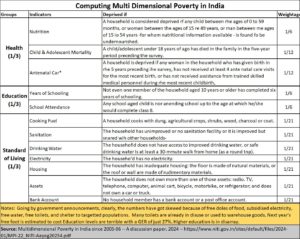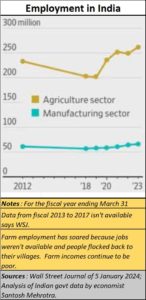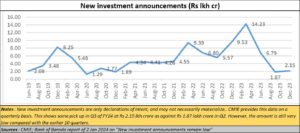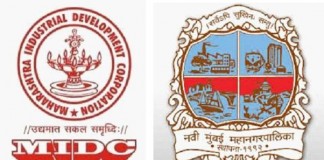Niti Aayog claims that poverty declined by 24.8 crore in nine years
By RN Bhaskar
The Bing generated image above shows all sorts of goodies being showered down on the people below. It is an adaptation of the legendary Indian rope trick. Niti Aayog announced that the present government had pulled out 248 million (24.8 crore) Indians out of multi-dimensional poverty or MDP (https://www.business-standard.com/india-news/248-2-million-indians-escaped-poverty-in-9-years-says-niti-aayog-124011500969_1.html) evokes similar images.
But first let’s look at the figures given out by Niti Aayog
The figures look amazingly wonderful compared to the estimates of poverty in earlier periods.
To understand how MD0 is calculated, it is important to go to the very basics of the parameters that are considered.
As Niti Aayog itself states in its discussion paper titled “Multidimensional Poverty in India since 2005-06 — A discussion paper. 2024” (https://www.niti.gov.in/sites/default/files/2024-01/MPI-22_NITI-Aayog20254.pdf), “Multidimensional poverty for India for the years 2005-06, 2015-16, and 2019-21, was estimated using data from the corresponding National Family Health Survey (NFHS) rounds . . .The estimates are computed with due consideration to the harmonization of indicators across the aforementioned survey rounds. . . . More than half of India’s population (55%) was multidimensionally poor in year 2005-06 and the intensity of poverty was also as high as 55 per cent. The proportion of multi-dimensionally poor persons in total population has fallen from 55.34% in 2005-06 to 24.85% in 2015-16 and to 14.96% in 2019-21.”
Moreover, these figures are at variance from those Niti Aayog itself provided in earlier years. A good sampling of the estimates on poverty can be found at https://asiaconverge.com/2022/08/taxing-the-poor-and-making-them-poorer/.
In a sharp contrast to earlier practices, when poverty estimates predominantly relied on income as the sole indicator, MPD looks at these 12 indicators. They are nutrition, child and adolescent mortality, maternal health, years of schooling, school attendance, cooking fuel, sanitation, drinking water, electricity, and housing.
While the weightages are equally divided among health, education and standard of living, the constituents show that just by tweaking two of the parameters relating to education and three relating to health, the results could be significantly influenced.
And this is where the problem lies. We have no idea of the way Niti Aayog went about surveying the results on the ground and relying only on “information available – is found”.
Education
But the government’s own figures presented before the Rajya Sabha on education shows that India enjoys a GER (gross enrolment ratio) of just 27.3 – pathetically low from any kind of global comparison with developing economies (more details about the government pronouncements can be gleaned from – free subscription – https://bhaskarr.substack.com/p/the-state-of-education-in-india).
Add to this other issues like the number of schools with internet connectivity, well equipped science laboratories, and schools with just a single teacher (all these issues have been discussed in the article referred to above), and it becomes clear that the marks that education deserves should have been abysmally low. That does not seem to be the case. The situation for higher education is equally depressing (https://bhaskarr.substack.com/p/the-state-of-higher-education-in?sd=pf).
Moreover, just last week, ASER’s rural school findings showed that among 14-18 year olds, barely 46% of youth can do everyday calculations (making them inept at any money transactions). The survey found that as many as 26.4% of the youths cannot fluently read Class 2-level text in their mother tongue, with girls doing better than boys. Only a little over half (57%)
can read sentences in English, of which three-quarters (73.5%) can tell their meanings.
Only 43.3% of 14-18 year olds were able to solve a three-digit by one-digit division problem
correctly, a skill they were supposed to acquire by Classes 3 and 4. Males tend to do better in
arithmetic and English reading than girls (https://www.freepressjournal.in/education/1-in-4-high-schoolers-cannot-read-half-cannot-do-maths-aser-2023-report).
Nutrition and health
That takes us to the second most weighty parameter, viz nutrition. Clearly, free food that the government has been providing the economically weak community has helped push nutrition values up. The people have not earned their daily meal, but have got this as doles. Normally, this work would have been done by charitable organisations – like the langars (public centres where free food is made available to anyone who wants it, often after some community service is first extracted from them) that the Sighs organise very efficiently and amazingly well. But the government has taken up this role in India.
Just last week, came the news that the government plans to double the cover for Ayushman Bharat, the government subsidised health insurance programme. Once again, with few doctors (https://asiaconverge.com/2018/08/ayushman-bharat-great-concept-doctors-overlooked/) , and rudimentary facilities, the doubling of cover is perplexing (https://www.businesstoday.in/union-budget/story/interim-budget-2024-govt-may-double-insurance-cover-under-ayushman-bharat-health-insurance-scheme-ahead-of-ls-polls-413739-2024-01-17)
Nothing wrong with offering subsidised medical insurance and medicare, or free food – often through the public distribution system (PDS) and through ration shops. But when people are given free food, or at highly subsidised rates, year after year, you get them hooked to doles, in much the same way drug addicts get hooked.
There are two other problems with such arrangements.
First, the quality of grain made available from ration shops is not of very good quality. Yet, as revealed by people whom this author has engaged in conversations, they still take the grain. Some of it is given away to pet animals or birds, and much of it is sold back in the market, and often goes to flour mills where it is mixed with other grain and sold at flour or other confectionaries. This is turn depressed the price of grain in the open market, causing farmers to be even more dependent on the minimum support price at which procurement agencies like the FCI (Food Corporation of India) picks up grain from the most influential of farmers (https://asiaconverge.com/2021/09/need-sensible-laws-to-stop-farmer-exploitation/). Small farmers who are not well connected, must fend for themselves at depressed prices in the market. This article also talks about how impoverished the farmer really is. That drives them further into poverty. That, in turn, makes them even more dependent on doles and subsidies, which they get in (implicit) exchange for votes at the time of election. That is why the high ratings Niti Aayog may have given to nutrition needs to be taken with a pinch of salt. When it comes to healthcare, the government has not focussed on increasing the intake of medical colleges. That in compels students to seek medical education overseas (better education at a fraction of the cost for India’s private colleges). So you have pronouncements and budgetary allocations without the underpinnings in place.
The second problem is that they take away much of the taxpayers’ money which could have been used for creating facilities which could have created more jobs. That in turn would have helped wean the poor and the unemployed off the doles and subsidies. Effectively, the government is pushing the economy into costs that turn out to be counter productive especially when employment is weak, and investment climate has become less attractive than in earlier years.
This is where India is likely to get into big trouble.
The chart will tell you how many lakh crores of rupees are spent on just food subsidy. Had this money been spent on education, or on creating facilities to create more jobs (more on this later), the poor could become wealthier without the crutch of subsidies. The nation would have become stronger.
The fact is that during the past few years, the government has pulled all stops to generate funds to finance its subsidies and doles. It has begun twisting the arms of public sector enterprises to cough up more through the declaration of higher dividends (https://bhaskarr.substack.com/p/the-shrinking-growth-of-the-middle?r=ni0hb&utm_campaign=post&utm_medium=web) and has even begun taking money from the central bank, the RBI.
Much of the money has also gone into infrastructure. Some of the infrastructure spending has been pushed through unwisely, even at the cost of delaying other investments on infrastructure which could have benefitted the Indian economy substantially. One excellent example of this is the way money was spent on the two Dedicated Freight Corridors (DFCs) — https://bhaskarr.substack.com/p/indias-two-dfcs-politics-trounces?r=ni0hb&utm_campaign=post&utm_medium=web .
The result is that when elections get over, and the government has little money left – either with its public sector units or through tax mobilisation (especially GST, which collects a percentage of the government spending on doles and other vote catching infrastructure). It may not have the money to continue financing its doles, except through additional borrowings which are already quite high.
The best way to reduce poverty is through education, skill development and job creation. The first two of these, as we have seen earlier, are in shambles.
The second is desirable. And while data shows that jobs have increased a very interesting article in the Wall Street Journal (of 5 January 2024, with data from the government that has been culled and analysed by economist Santosh Mehrotra) shows that the increase in jobs was largely in the farm sector. This is a sector that is already burdened with excessive employment.
So why did farm employment go up? The reason is quite simple. Much of farm labour works on the land only during harvest and showing times. The rest of the time the workers actually work in cites as courier boys, drivers, and casual labourers. They send their income back home to support an impoverished rural family.
But with urban jobs not growing substantially (watch the deceleration in jobs both in manufacturing and in services at https://bhaskarr.substack.com/p/india-prognosis-2024?r=ni0hb&utm_campaign=post&utm_medium=web), many youth have opted to go back to their respective villages, where the cost of living is low. City costs have become unaffordable in the face of economic slowdown. That explains the surge in rural employment. It is not something to be proud about.
One of the reasons why jobs are not picking up is because of the slowdown in investments. As these columns have pointed out several times, private investment is flagging. The raids, seizures, threats of imprisonment, have driven away many businessmen and citizens alike are leaving India in droves (https://asiaconverge.com/2023/09/inflated-views-and-deflated-economy/). When the wealthy – who create factories and thus jobs – choose to stay away from India, employment is not likely to pick up.
The investment climate is certainly looking less attractive than in previous years. Just look at the dip in investment proposals that have been announced. Yes, it is true that new investment announcements are only declarations of intent. They may not materialize. But they point to the attractiveness of India as a destination of investments. Data compiled by CMIE provides this data on a quarterly basis. This shows some pick up in Q3 of FY24 at Rs 2.15 lakh crore as against Rs 1.87 lakh crore in Q2. However, the amount is still very low compared with the earlier 10 quarters. As pointed out in earlier articles (https://bhaskarr.substack.com/p/fdi-figures-tell-many-tales?sd=pf) India’s inbound investments remain lacklustre, while outbound investments appear to be soaring.
But Niti Aayog believes India has successfully pulled out 25 crore people out of poverty. Facts on the ground do not support this glowing estimate.










































COMMENTS